Bryanna Clark Grogan’s Vegan Feast Kitchen/ 21st Century Table: The kitchen journal of a vegan food writer.. I'm on Facebook and Twitter (see links in sidebar at right).
Friday, October 7, 2011
GLUTEN-FREE BAKING DAY-- ONE SUCCESS, ONE FAIL

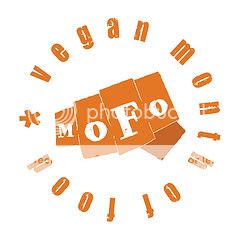
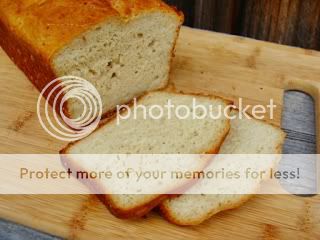 My Gluten-Free "White" Yeast Bread
My Gluten-Free "White" Yeast BreadI have several friends and a relative or two who are gluten-sensitive, so I've been doing some research on gluten-free vegan baking. We're having one Thanksgiving dinner at my son's tomorrow and his wife is not eating gluten but wanted to make her special stuffing recipe. So, I volunteered to make her a couple of loaves of gluten-free bread. I also decided I'd make a gluten-free pie.
THE SUCCESS:
I had already developed a vegan, high-fiber, gluten-free bread loaf for a friend a few years ago, and I decided to follow that recipe, but make it more"white" (even though it's still high-fiber-- brown rice flour is quite pale-colored). I changed my original recipe by using golden flax instead of brown flax seeds in both my flour mix and the bread recipe itself; by using maple syrup instead of molasses; and omitting the soy or rice milk powder. Otherwise it was the same.
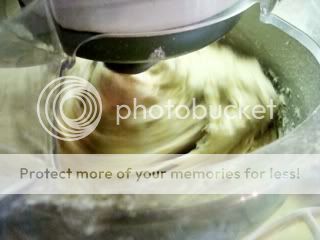 The dough (actually a thick batter) is beaten for only about 3 minutes.
The dough (actually a thick batter) is beaten for only about 3 minutes.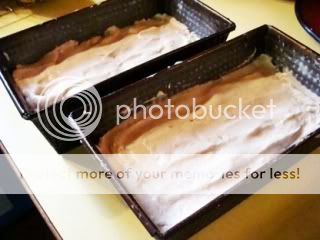 Then it's divided into two prepared 8 x 41/2" pans and set to rise for an hour to 90 minutes.
Then it's divided into two prepared 8 x 41/2" pans and set to rise for an hour to 90 minutes.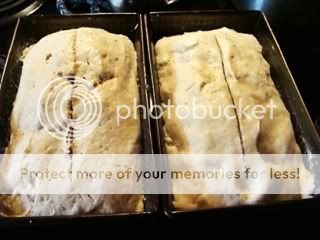 When it rises to the top of the pan it's ready to bake.
When it rises to the top of the pan it's ready to bake.The result-- not a high loaf, but it slices well, is moist and tasty (maybe a bit sweet-- I'll have to work on that) and toasts nicely, too. My DIL was pleased with it. (See the recipe below.)
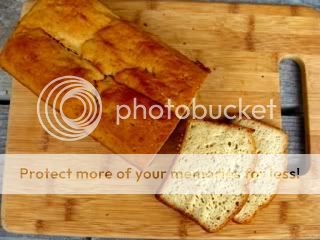
THE FAIL:
Sorry, no pictures! I didn't even think about photographing the debacle that was my first gluten-free pie crust until afterwards! So, a description will have to suffice. I should have known better and started with a conventional crust, but, instead, I decided to try my low-fat olive oil pastry for a freeform pie using the same flour mix I used for the bread. Bad idea! It was difficult to roll out and kept cracking, unlike the pliable and easily-handled wheat flour olive oil pastry. I soldiered on, however, and cobbled together a very sad-looking apple tart. When baked, the filling was lovely (I added some homemade crab-apple butter to the apples), but the crust dry and hard. Not one to waste food, I served it anyway, with almond milk poured over it in bowls, like a sort of pudding. This softened the crust and it was edible, especially with the delicious apples.
Tomorrow I'm making a pecan pie for the dinner at my son's house, with a conventional high-fat pie crust made according to the recipe in Silvana Nardone's book "Cooking with Isaiah" and my own vegan filling.
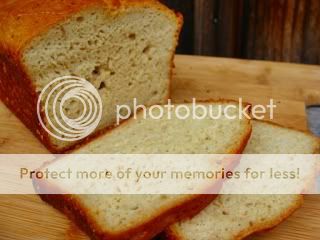
BRYANNA'S GLUTEN-FREE “WHITE” VEGAN YEAST BREAD (GF, SF)
Makes two 8 1/2 x 4 1/2" loaves
Even though the flour mixture contains high-fiber brown rice flour, chickpea flour and ground flax seed, this makes a nice “white” loaf.
NOTE: Grease the pans really well with non-hydrogenated shortening-- this bread sticks easily. (I like these pans.)
Yeast Mixture--mix and let stand 5 minutes:
1 3/4 c. warm water
1 packet regular active baking yeast (2 1/2 tsp.)
(NOTE: If you have only instant yeast, use only 1 3/4 tsp.)
1 tsp. sugar
Flax Mixture-- meanwhile, whiz in a blender:
1 c. warm water
1/4 c. golden flax seeds
The result:
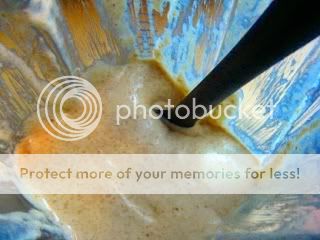
When the mixture is frothy, with just bits of flaxseed hull in it, add and blend:
The result:

When the mixture is frothy, with just bits of flaxseed hull in it, add and blend:
2 T. plus 2 tsp. Ener-G egg replacer powder or Orgran No-Egg
1/4 c. olive oil or melted Earth Balance
1/2 tsp. agar powder
1 1/2 tsp. vinegar
4 tsp. maple syrup, agave nectar, or brown rice syrup
Dry Mix--in a bowl, mix well:
4 c. Bryanna's Gluten-Free “White” High-Fiber Flour Mix (see mix recipe below)
1/4 c. instant mashed potato flakes
6 T. unbleached organic sugar (I’m going to try using less sugar next time)
1 T. + 1 tsp. xanthan gum or guar gum
1 T. salt
Add the frothed-up Yeast Mixture to the Flax Mixture in the blender and blend briefly. Dump this into the bowl of a stand-up electric mixer. Using the whip attachment, gradually beat in the Dry Mix until it is all mixed in. Beat on high for about 3 1/2 minutes. Scrape the dough (it's actually a really thick batter) evenly into the prepared pans and smooth the tops flat. Cover and let rise in a warm place 1 to 1 1/2 hours, or level with the tops of the pans. (You can slash the top of the loaf with a sharp knife or razor blade, or not, as you prefer.)
Have the oven preheated to 400 degrees F. Bake the breads for 20 minutes, then reduce the heat to 350 degrees F and cover the breads with loosely foil. Bake for 30 minutes more. Loosen the edges with a table knife and carefully remove the loaves from pans to a rack to cool before slicing. This really looks, smells and tastes like bread. You can toast it and make breadcrumbs or bread crumbs out of it.
BRYANNA'S "WHITE" GLUTEN-FREE HIGH-FIBER FLOUR MIX
Makes about 13 cups
I designed this mix to work in most simple recipes as an all-purpose flour, but to be higher in nutrition and fiber than most GF mixes.
I designed this mix to work in most simple recipes as an all-purpose flour, but to be higher in nutrition and fiber than most GF mixes.
7 1/2 c. brown rice flour (as finely-ground as possible) (I used Bob's Red Mill organic)
2 1/2 c. potato starch (NOT potato flour—it’s not the same product)
1 1/4 c. tapioca flour (or tapioca starch—in this case it’s the same thing)
1 c. ground golden flax seed
1 c. chickpea flour
4 1/2 T. xanthan gum
Subscribe to:
Post Comments (Atom)

12 comments:
Oh thank you! I'll give this a shot when mofo is over!
Thanks Bryanna.
xo
kittee
I'd love to get your feedback, Kittee!
THANK YOU for accommodating your gluten-free friends and relatives! It's really amazingly huge to be included -- I hope they appreciate you greatly!
Your flour mix looks to me like it should substitute one-for-one for regular flour -- except that the amount of xanthan gum is alarmingly off. I usually use the rule of thumb of 1/2 teaspoon of xanthan gum for each cup of flour. So 13 cups of flour mix would need 6 1/2 teaspoons of xanthan gum. Using too much xanthan gum could be what made the finished pie crust come out hard.
Also, I'm leery of using bean flours, because some people are genetically wired to think they taste wildly rancid and awful. I don't have that gene, so bean flours taste fine to me, but I've made food for people who had problems with the taste of bean flour ingredients that I couldn't taste at all. So I've learned that if I'm cooking for anybody outside my family, unless I'm really sure that they are OK with bean flour, I replace it with either brown rice flour or quinoa flour.
I'm not sure what made the pie crust dough hard to work with. Maybe it needed more liquid?
Possibly useful: I like the pie crust recipe from the book "Food Allergy Survival Guide." The whole book is gluten-free and vegan. The pie crust recipe uses mostly olive oil for the fat, if I remember right. There is a small amount of coconut oil in the recipe, but I replace that with canola or olive oil to lower the amount of saturated fat and make it healthier.
I think it is exceedingly cool that you are cooking food that your gluten-free people can eat. Not many people do make the effort, so when someone does it is really appreciated.
eValerie, thanks for your input. The xanthan gum thing needs work, I admit, though it works for the bread. As for the crust, the mix seemed to soak up more water than a wheat crust. This was not a conventional crust, mind you-- it contains only a little bit of olive oil, which made it a bad candidate for this experiment. I made some of Silvana Nardone's GF flour mix, so I'm going to try her crust today. Julie Hasson said it worked well.
As for the bean flour, I detected no bean taste (only 1 cup out of 13). I like the taste of chickpea flour, anyway. I just like to add some nutritious flour because of all the white starch flour you have to use in it.
Who says you can't eat well either gluten free or vegan.
Exactly right, chefncurt! I have 2 vegan pecan pies with Silvana Nardone's GF crust (plus another little apple tart with the leftover apples from my "fail") in the oven as I write, for our Canadian Thanksgiving at my son's house tonight.
What I mean about the bean flour is that it tastes perfectly fine to me, but about 1 in 3 people's bodies are different and it tastes horribly vile to them. Because of that, I avoid using bean flours if I'm baking for anybody outside of my family.
If you have access to quinoa flour, it is nutritious and doesn't have the problem that bean flours have, so it might be another option.
In case it's useful, here's an article that I liked, from the current issue of "Living Without" magazine, that talks about other nutritious gluten-free flour alternatives (amaranth, buckwheat, etc.) --
http://www.livingwithout.com/issues/4_16/power_flour-2653-1.html
Thanks again for the tips, eValerie. I'll keep them in mind. I can grind quinoa flour in my Wondermill if need be. I always have chickpea flour around, so it's cheap and handy. So far, no complaints (I use it in alot of things, not just gluten-free).
A thought: Did you say that you grind your own chickpea flour? I wonder if that's the difference. The people who don't like the taste of it often say it tastes rancid. So maybe freshly ground chickpea flour doesn't taste rancid to them because it is fresh. (My chickpea flour is storebought, so I have no idea how old it is.)
No, I've been using store bought chickpea flour, but I could grind my own inn the Wondermill (some machines can't do beans). Also, I keep alot of my flours, especially higher-fat flours, in the freezer.
Hi Bryanna,
I have just switched to gluten free for my son and I (we've been vegan for a few years now), and I've been perusing your site for recipes because we love everything you make! I made your high fiber flour mix, and just came across this post while looking for a pancake recipe...
I wonder, to make this bread, could I use agar flakes instead of powder? I have the flakes on hand, and agar powder is kind of expensive... I've subbed the flakes in other recipes - would it work here? And if so, how much would you use?
Thank you so much for all your wonderful hard work - we LOVE your recipes! :)
herbivoreadventures.com You have inspired me to start a Gluten-Free Recipe List! ( http://veganfeastkitchen.blogspot.ca/p/gluten-free-recipes.html )
About the price of agar powder-- it is deceptive because the agar powder has so much less volume than the agar flakes that it looks like you are getting more with the flakes. But if you go by weight it's not so different! You only need 1/6th the amount of powder compared to the flakes! I checked on amazon.com and you can get 8 oz. of agar powder for $26.60 http://tinyurl.com/cr4wd2f or 9 oz. for $20.25 at http://www.bulkfoods.com/whole-foods.asp?wholesale=4703 (and this will last you for a long time!), whereas the cheapest agar flakes I could find were 3 oz. for $22.02 at amazon ( http://tinyurl.com/8e3p9sz ). The powder is so easy to use and store and find, that I would never go back to using flakes!
Post a Comment